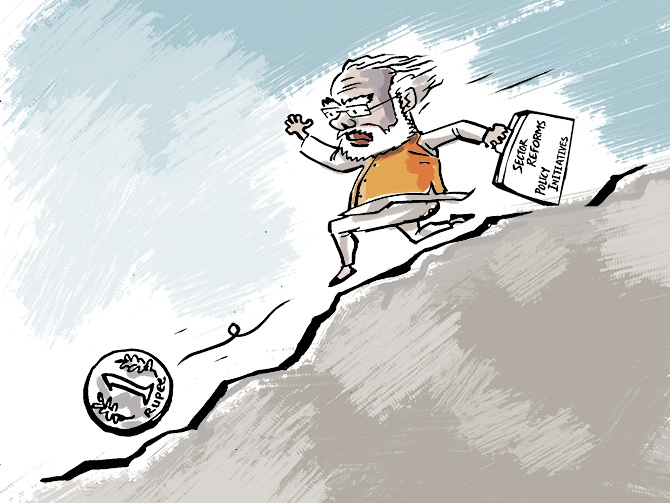
Beware! Economy headed for greater trouble
- Select a language for the TTS:
- UK English Female
- UK English Male
- US English Female
- US English Male
- Australian Female
- Australian Male
- Language selected: (auto detect) - EN
Play all audios:
'The large scale and widespread shrinking of the labour force in November, the peaking of unemployment in October and the fall in lead indicators in October and November point towards a
worsening of the slowdown of the Indian economy in the third quarter of 2019-20,' says Mahesh Vyas.
The fall in real GDP in the quarter ended September 2019 to 4.5%, the lowest in over six years, was an official admittance of a fact well known for long.
But it seems mild compared to what we see beyond the second quarter.
Available data tell us that the economy is headed for even greater trouble in the current quarter which ends in December 2019.
Conventional electricity generation in October 2019 was a whopping 13% lower than it was in October 2018.
Thermal power plants had to be shut because of lack of demand.
This is perhaps, the most damaging evidence of a severe slowdown underway.
But the fall in October has turned out to be exceptionally nasty.
Natural gas production has been falling similarly and continued to do so into October.
Coal imports were 12% lower in October 2019 compared to a year ago.
And crude oil imports were lower by 20% in a similar comparison.
Naphtha, aviation turbine fuel and diesel consumption have been falling similarly as well till October.
The overall consumption of petroleum products in October was 1.5% lower than it was a year ago.
Railway freight was down by 8 per cent. Core sectors collectively logged a fall of 5.8% in October.
The stress showed up in October in the form of a spike in the unemployment rate.
In November, the labour force itself shrank as large chunks of labour seem to have left the labour markets that could not provide sufficient jobs.
This, perhaps, is an early indication that the overall economic conditions have worsened in November.
An exodus from the labour markets is a bigger indication of economic stress than an increase in the unemployment rate.
But during an economic downturn, the unorganised sectors are likely to have suffered more than organised ones.
Contraction in their business or even a slowdown is inadequately captured in the official quarterly GDP statistics.
Fast frequency labour statistics as produced by CMIE from its Consumer Pyramids Household Survey is a more comprehensive measure of the health of the economy.
Since this is a large household survey it includes people working in organised and unorganised sectors, in large and small organisations and working age populations in rural and urban
regions.
A combination of high unemployment followed by fall in labour participation is a bigger indicator of stress than can be gauged by any one of these two indicators.
The Consumer Pyramids Household Survey tells us that the labour force participation rate shrank by 77 basis points to 42.37% in November 2019.
This was its lowest level since January 2016 when CMIE began these measurements.
The labour force shrank by an estimated 7 million in just a month.
These are very big falls which cannot be explained by random statistical variations in a monthly series.
There were only three months since January 2016 when the rural labour participation rate was lower.
The rate fell by 85 basis points in urban India and 73 basis points in rural India in November, compared to October.
Arguably, a very worrying observation is the sharp fall in the male labour participation rate.
This fell by 119 basis points, from 71.74% in October to 70.55% in November.
Here, the fall was limited to urban women, where the rate fell 74 basis points from 10.16% to 9.42%.
Fifteen of the 25 states tracked by the Consumer Pyramids Household Survey saw labour participation rates shrink in November over October.
Besides labour statistics from the Consumer Pyramids Household Survey, we see stress in the two additional fast-frequency indicators released so far.
And the manufacturing PMI at 51.2 in November and 50.6 in October shows that the stress in the sector continues into the third quarter.
This large scale and widespread shrinking of the labour force in November, the peaking of unemployment in October and the fall in lead indicators in October and November point towards a
worsening of the slowdown of the Indian economy in the third quarter of 2019-20.
Mahesh Vyas is Managing Director and CEO, Centre for Monitoring Indian Economy Pvt Ltd. Mahesh frequently contributes to Business Standard newspaper.